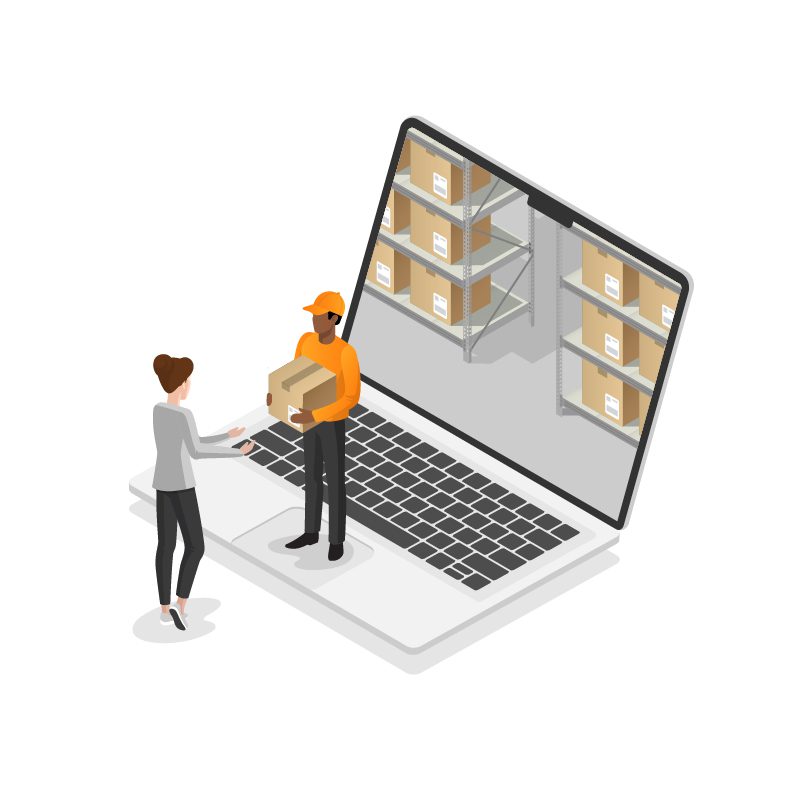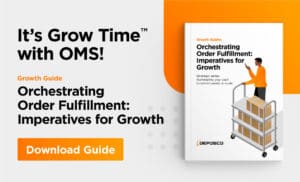Just starting your OMS journey?
You’re at the first waypoint. When you’re ready to shift into high gear and see how industry leaders are crushing complex supply chain challenges, check out our order management software.
Escaping ‘survival mode’ – What OMS is (and what it isn’t)
An order management system is a technology framework that helps businesses manage and track customer orders more efficiently and accurate, from click to fulfillment to delivery. It’s what gets retail, ecommerce, and 3PL companies out of survival mode and into long-term growth mode.
Tap into robust OMS and DOM features. Inspect inventory across all channels including DTC. Automate order allocation. Manage the entire order lifecycle with full visibility and efficiency, and make decisions with confidence.

Especially in multichannel and multi-location environments, order management reduces the time required to manage orders through process automation, real-time information and tracking, and lightning-fast integrations with other supply chain systems.
 Order management systems introduce advanced tools – such as intelligent order routing, customer address cleansing, real-time inventory publishing across channels, and the ability to make last-minute changes to the sourcing and delivery methods of orders. This adds an extra degree of confidence, speed, and savings in meeting your customer’s rapidly evolving expectations.
Order management systems introduce advanced tools – such as intelligent order routing, customer address cleansing, real-time inventory publishing across channels, and the ability to make last-minute changes to the sourcing and delivery methods of orders. This adds an extra degree of confidence, speed, and savings in meeting your customer’s rapidly evolving expectations.
To be clear, there are differences between an OMS and WMS.
- Order management software focuses on managing orders across various channels, handling the entire order lifecycle from placement to fulfillment. Cloud-based OMS tracks orders, inventory, and customer information in real time within a centralized system.
- A WMS (warehouse management system) is more about managing and optimizing warehouse operations processes including picking, packing, shipping, and receiving. A WMS focuses on inventory movement and storage within the warehouse. More modern omnichannel fulfillment solutions take a next-gen approach, delivering end-to-end WMS and OMS capabilities in a single, real-time platform.
How an OMS works
An OMS centrally coordinates real-time data around order processing, inventory management, shipping, invoicing, planning, and performance monitoring. It assists businesses with strategic order allocation and fulfillment by providing a holistic view of the entire supply chain ecosystem.
Businesses selling via multiple channels or locations can reliably monitor stock availability and track inventory movements across multiple touchpoints based on information that’s highly accurate and easy to access. This drives next-gen operational efficiencies, speed, precision, and cost savings, significantly reducing stockouts, backorders, overstocks, and poor customer experiences.
When is the right time for OMS?
Once a business has its warehouse management operations in order, it begins to explore new strategies to scale order fulfillment, going beyond simply executing inventory.
Typically, that curiosity happens after they realize their warehouse operations are not on par with their long-term growth goals due to several problems, which we all can agree are reaching fever pitch:
- Unsustainably high demand and order volume, especially in DTC fulfillment
- Customer service issues that have lofty consequences
- Rising operational costs and labor problems
- Or simply the desire to offer new sales channels and buying options
How do you solve these challenges and set up your business for long-term profitability moving into the next decade? Scaling fulfillment for omnichannel will take more than that Y2K-era supply chain system can handle!
Benefits of order management systems
OMS systems extend your reach to multichannel shoppers, who spend 4 times as much as in-store customers and 10 times more than digital-only customers, according to IMD research with Target. But, it’s about much more than top-line growth.
Order management systems orchestrate consistent product information, availability, ordering information, post-purchase information, and returns information regardless of channel – in a controlled, transparent, and profitable way.
- Higher revenues and engagement in omnichannel
- Confidence that customer promises are kept
- Simplicity, speed, and flexibility
- Seamless workflows with other systems
- Fast, accurate fulfillment processes
- Ability to orchestrate orders from any channel to meet customer demands
☑️ Higher revenues
An intelligent order management system brings all your sales channels into one view to empower customer engagement across all sales channels.
For omnichannel to happen, your OMS system should sit between your ecommerce platforms and fulfillment network. Because the OMS coordinates the function of back-end systems with customer-facing channels, it plays a crucial role in optimizing your multichannel commerce operations.
Order management systems can perform essential omnichannel commerce functions such as:
- Provide up-to-date info on available inventory everywhere
- Catch errors in your order data
- Manage order cycles from start to end
- Select the optimal fulfillment location
- Send order updates back to the sales channel
- Manage exceptions during the order lifecycle
SPECIAL REPORT: Omnichannel Order Fulfillment Trends and Strategies
☑️ DTC excellence
With the explosive growth in DTC ecommerce, you will likely have to fulfill multiple orders – often for a single item commonly referred to as “eaches” in the warehouse – on your website while other customers are purchasing items simultaneously in your stores. So, you have to know right away what inventory is available to avoid offering products not in stock on your website.
Consumers also want to be kept informed about the status of their orders. So, your OMS must provide real-time information on direct order fulfillment status, shipments, and expected delivery date.
In filling those orders, you also want to avoid excessive handling and shipping expenses. OMS systems direct orders for fulfillment to the optimal warehouse or store in your network.
SPECIAL REPORT: How big is the North American DTC Market?
☑️ Nothing oversold
The real-time inventory visibility of OMS helps avoid canceling customer orders and disappointing buyers because you over-promised inventory across all your sales channels.
Read more: Prevent Overselling Inventory – How does it happen and the implications.
☑️ High delivery standards
OMS automation is increasingly important to keeping your customer promise: fast delivery and correct orders (but with less effort). Whereas manual order fulfillment results in late and incorrect shipping, an OMS accepts orders digitally and imposes discipline on the process to avoid errors at or above 99% accuracy.
☑️ Cost control through DOM
Selecting the wrong location for order fulfillment results in late shipments or higher pick, pack, and shipping costs. A smart OMS leverages distributed order management (DOM) to assign the order to the optimal location, significantly controlling distribution costs and meeting delivery promises.
☑️ On-time deliveries
When a customer doesn’t get a shipment at the expected time, the poor service experience threatens repeat buying and customer loyalty. A modern OMS, however, can integrate seamlessly with systems, like WMS and rate shopping solutions or transportation management systems (TMS), to improve revenue and ensure delivery commitments are met.
Feeling the squeeze to improve your on-time delivery? Read what it takes to easily provide accurate shipping estimates, directly increase your revenue, overall customer satisfaction, and ultimately cinch your competitive advantage.

Order management’s role in omnichannel
An OMS assumes that the warehouse’s basic puzzle pieces of executing omnichannel fulfillment are on auto-pilot. It means moving beyond reactionary questions, like: “How much inventory do we have? Where is it located? What can we automate in the warehouse?”
The question becomes more strategic with OMS: “How can we improve, scale, rinse, and repeat to grow profitably?”
Order management is the vital catalyst to scaling omnichannel, which should be top of mind for you right now. Compelling omnichannel statistics prove this point:
- Businesses that market in 3+ channels earn a 287% higher purchase rate than those using a single-channel campaign
- Companies with an omnichannel engagement strategy retain 89% of their customers, compared to 33% for those with weak omnichannel strategies
- Multichannel consumers spend 4X as much as store-only consumers, and 10X more than digital-only consumers
[demo_form title=”Boost Your Operational Efficiency and Growth with Deposco” lead=”Discover how Deposco’s OMS can simplify your supply chain, accelerate revenue, and help your business thrive.”]
We’re GROWING. Now How Do We GROW FASTER?
Order management is the turning point for companies looking to parlay their successes into larger growth initiatives and bring their omnichannel vision into clear focus. OMS and distributed order management system (DOM) automate and streamline customer touchpoints into a single lens of truth. Having a coordinated view across the enterprise enables a unified buying experience while streamlining all the activities involved in receiving, processing, fulfilling, and tracking orders.
It’s the secret sauce behind companies that are—for the first time—giving Amazon real, head-to-head competition. A prime example is Shopify. The company started in 2004 as an online snowboard gear shop and is now a $10 billion commerce ecosystem that shockingly surpassed Amazon’s online traffic in Q2 2021.
Shopify now receives more online traffic than Amazon. The average number of monthly unique visitors for ecommerce sites powered by Shopify reached 1.16 billion, compared to Amazon’s 1.10 billion visitors during the same period. Proof that companies of any size can win.
Related article: Why you need an integrated Shopify OMS
Which OMS capabilities matter?
Our work with some of the fastest-growing businesses reveals the top 5 OMS features essential to rapid, sustainable growth, massive cost savings, and seamless data flow:
- Automated Fulfillment – Eliminate manual processes to boost efficiencies, reduce errors, and empower workers.
- Drop Shipping – Reduce time-consuming communication with drop-ship partners and guesswork. Find the optimal drop-ship method of the day, directly in the system.
- Right Inventory Management by Channel – Represent the properly configured available inventory levels for every item, from various inventory sources.
- Automatic Order Routing – Properly route orders and ensure availability in situations like alternative fulfillment sources, split orders, and exceptions.
- Pre-Ordering – Understand items available for pre-order without going into the ecommerce system. This boosts sales, profitability, and brand reputation.
Grab the guide below to dig deeper into which OMS features matter most and what you can do with them:
It sounds like I need an OMS. How do I choose the right one?
Be careful when selecting an OMS system. Just as it is when buying your WMS, with your OMS – timing, need, and fit are everything.
☑️ Think about platform architecture in OMS
You’ll want to avoid the “Frankenstein” tech stack, or vendor acquisition-based suite of products built and integrated by multiple point solution players – all with different architectures, value statements, and implementation groups – versus developed as a single platform. You’re basically hiring 3 or 4 different groups rather than a single provider. This often causes integration and performance-draining surprises.
☑️ Think about compatibility between your WMS
To be clear, an OMS is not a WMS. Learn the difference here: What is a WMS (warehouse management system)?
Ideally, consider an OMS that is integrated with your WMS to provide real-time inventory and order fulfillment information across your network of warehouses and fulfillment centers.
Read why OMS and WMS are better together.
☑️ Think about OMS in your stores
Bonus if the platform also offers an easy connection to your store inventory fulfillment system – whether you implement this now or add it in the future when it’s needed. Store-compatible OMS solutions like Deposco Bright Store provide accurate store inventory, which is critical to your success with Buy Online, Pickup In Store (BOPIS), and Buy Online, Ship from Store (BOSS). These solutions show exactly what you have listed as available on your website, eliminating stockouts during order fulfillment.
Learn how Psycho Bunny did this.
Think beyond the webstore
When people think about OMS systems, they think “omnichannel” — That’s just for retailers or brands with physical stores, right? Myth!
The rise of DTC fulfillment, marketplaces, and fulfillment “however the customer wants it” has reversed this notion. Learn how an ecommerce OMS system benefits your business even if you do not operate brick-and-mortar stores.
Think beyond the single facility
Even if you do not have physical stores, or fulfill from only one location, consider investing in an intelligent order management system that is designed and built for omnichannel commerce. These systems offer specialized features that benefit your business in the areas of shipping efficiencies, real-time collaboration with trading partners, reduced order cancelations, and more.
Learn how OMS drives shipping efficiencies in single-facility operations.
Think about external supply chain systems
On top of that, your OMS has to be able to exchange data with suppliers, carriers, third-party solutions, and any third-party logistics company (3PL) handling fulfillment on your behalf. This ensures you have the real-time information you need to keep orders running smoothly and efficiently.
For example, Deposco’s Bright Order OMS software is built on the same codebase as our WMS and retail fulfillment software applications. That means our platform has built-in, seamless integrations to facilitate a ready exchange of information between all your fulfillment touchpoints.
Bright Order also integrates with your external supply chain partners for order routing, sourcing, shipping, MHE, TMS, and more. This enhances the omnichannel experience for your customers by reducing fulfillment times, costs, and other complications.
Going with a flexible platform also makes it easy to extend high-demand order fulfillment options such as buy online, pick up in-store, or ship direct from store.
Meet Deposco, the planet’s most modern and scalable order management software! Get a demo.


